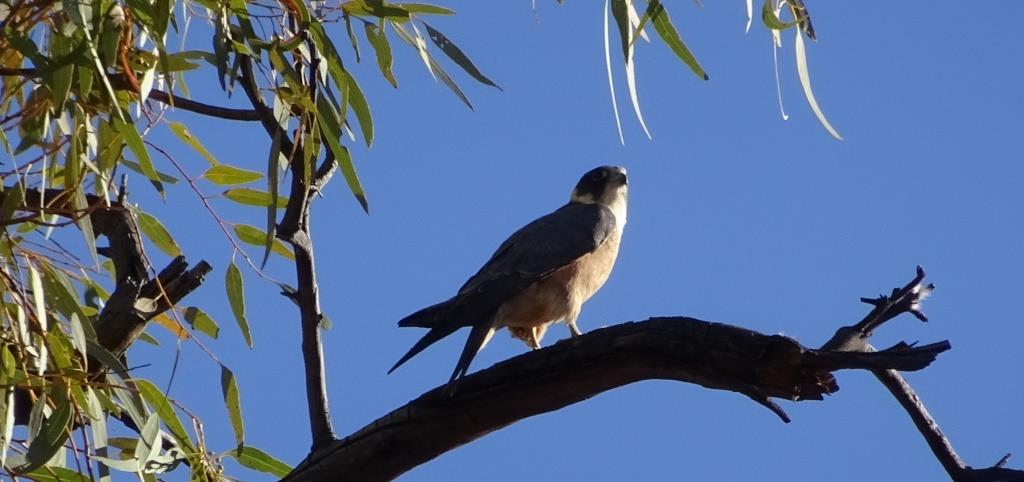
In early August of this year, a pair of Black-breasted Buzzards (Hamirostra melanosternon) were found dead under their nest in the Todd River, around the Amoonguna area. Concerningly, three to four weeks later a pair of Little Eagles (Hieraaetus morphnoides) were also found dead on the ground under their nest, approximately 100 m from where the Buzzards were discovered. The carcasses were too decomposed to enable authorities to conduct tests on them, but it was noted that the skeletons were intact and didn’t appear to have been shot. One of many possibilities being considered for the suspicious mortalities is secondary poisoning from Pindone.
So now seems an opportune time to provide an update about Pindone use in the NT and raise awareness of other options that are available.
Pindone is primarily used to reduce Rabbit (Oryctolagus cuniculus) populations in areas where it is impractical or unsuitable to use 1080 poison (e.g. urban/residential and semi-rural areas), a Schedule 7 chemical which requires a permit for use. Pindone is an anticoagulant and takes a number of exposures for the target animal to reach a lethal level where the animal essentially bleeds to death internally. Although it can be effective for controlling rabbit populations, the use of Pindone can impact non-target species that are exposed to the poison, including wildlife. Dogs and Cats can be affected if they ingest large doses, but animals that are particularly susceptible to direct poisoning from Pindone are Wallabies, Kangaroos, and seed-eating birds. Birds of prey are also at risk of death through secondary poisoning; as poisoned Rabbits become lethargic and less aware of their surroundings, they become more vulnerable to predation by raptors.
NT Governance of Pindone Use
Pindone is registered for use in the Northern Territory both as a bait concentrate, which needs further preparation before use, and as a ready-to-use form where the Pindone is supplied already applied to an oat bait. The bait concentrates are declared to be ‘restricted chemical products’ under Schedule 4 of the Agricultural Veterinary Chemicals Code Regulations 1995. Restricted chemical products may only be supplied and used by ‘authorised persons’ (for example, qualified pest controllers). The ready-to-use forms of bait are not declared to be restricted chemical products.
However, all forms of Pindone, whether declared ‘restricted chemical products’ or not, must only be used and applied in accordance with directions from the appropriate State or Territory Department in compliance with the relevant State or Territory legislation. In the Northern Territory, you are required to contact the Chemical Services Branch at the Department of Primary Industry and Resources (Phone: 08 8999 2344; email: chemicals@nt.gov.au), to determine what steps you need to undertake to be able to use Pindone baits in the situations you require. Generally this will require you to have access to appropriate management. Such a plan includes initially providing ‘free’ feeds to gain an understanding of who/what is being attracted to the bait, how to lay the bait, carcass removal, prevention of availability to non-target species, and so on. Management plans are readily available online.
Alternative Control Methods
There are several other options available for Rabbit control. Methods such as warren ripping and trapping are less harmful for wildlife. Remember though, any type of Rabbit control method won’t do much good in the long term if initial efforts are not followed up with further control methods such as removing or excluding rabbits from potential habitat and attractants. Rabbit virus releases such as the recently (2017) released calici virus, and warren fumigation, are more appropriate for use by qualified pest controllers. While these are more specific, their use is more technical and it is difficult to obtain Schedule 7 fumigants.
NT Parks and Wildlife would like to hear from anyone that is using Pindone on their property, especially given these recent raptor deaths. Additionally, if you observe any mass mortality events (such as the recent Rainbow Bee-eater’s plight at Ilparpa), or wildlife with suspected infectious diseases, please contact John Tyne at the Department of Parks and Wildlife: 8951 8283, 0401 115 731, wildlife.management@nt.gov.au.
It would also be a great help to John if you could collect a fresh sample (carcasses less than 12 hrs old). These samples are sent off to a veterinary pathologist in Darwin for assessment and analyses.
As an adjunct, if someone is using Pindone, they could contact a group of researchers in the ACT who are conducting research on secondary poisoning. I am sure they would be pleased to know of another potential data source for their project and you might even have the opportunity to take part in their research!
You can read more about Rabbit Control in the Land for Wildlife fact sheet or check out the other Feral Animal Resources on the Land for Wildlife website. Also, check out the January 2017 Newsletter for more info on Rabbits and virus releases.
~ Kate Stevens
Categories:
Bird, Bird Watching, Mammals, Trapping